
~ Latest Titles in the Build It Yourself Series ~

 Nomad Press is committed to preserving ancient forests and natural resources. We elected to print Backyard Biology: Investigate Habitats Outside Your Door on 4,007 lbs. of Williamsburg Recycled 30% offset.
Nomad Press is committed to preserving ancient forests and natural resources. We elected to print Backyard Biology: Investigate Habitats Outside Your Door on 4,007 lbs. of Williamsburg Recycled 30% offset.
Nomad Press made this paper choice because our printer, Sheridan Books, is a member of Green Press Initiative, a nonprofit program dedicated to supporting authors, publishers, and suppliers in their efforts to reduce their use of fiber obtained from endangered forests.
For more information, visit www.greenpressinitiative.org.
Nomad Press
A division of Nomad Communications
10 9 8 7 6 5 4 3 2 1
Copyright 2013 by Nomad Press. All rights reserved.
No part of this book may be reproduced in any form without permission in writing from the publisher, except by a reviewer who may quote brief passages in a review or for limited educational use.
The trademark Nomad Press and the Nomad Press logo are trademarks of Nomad Communications, Inc.
This book was manufactured by Sheridan Books,
Ann Arbor, MI USA.
February 2013, Job #344176
ISBN: 978-1-61930-151-1
Illustrations by Beth Hetland
Educational Consultant Marla Conn
Questions regarding the ordering of this book should be addressed to
Independent Publishers Group
814 N. Franklin St., Chicago, IL 60610
www.ipgbook.com
Nomad Press
2456 Christian St.
White River Junction, VT 05001
www.nomadpress.net
Contents
I NTRODUCTION
B ECOME A N ATURE D ETECTIVE
C HAPTER 1
T HE S TUDY OF L IFE
C HAPTER 2
C ELLS A LIVE!
C HAPTER 3
M ICROBIOLOGY R EVEALS AN I NVISIBLE W ORLD
C HAPTER 4
P LANTS M AKE L IFE P OSSIBLE
C HAPTER 5
P LANT L IFE C YCLES
C HAPTER 6
A DAPTATIONS A RE A M ATTER OF L IFE AND D EATH
C HAPTER 7
A NIMAL L IFE C YCLES
C HAPTER 8
P ROTECT L IVING T HINGS
Introduction
Become a Nature Detective

L ife in all its wonder is everywhere. It thrives in the city. It blooms in the country. Life flourishes in deserts, forests, and oceanseven in the Arctic. You can find a place to explore living things almost anywhere you go. But you dont have to go too much farther than right outside your door!
Your own backyard is an ideal place for investigation. Parks, playgrounds, and nature preserves are outdoor science labs. Discover life over your head, under your toes, and all around you. Ask questions, make predictions, and record your observations. Think like a scientist. And have fun connecting with the astonishing natural world.
Become A Nature Detective

Detectives use special tools of the trade to track down clues and solve mysteries. Assemble your own toolkit to scout for nature clues. Stash supplies in a backpack. Hang it in the same place all the time, so its always ready and waiting. Include binoculars to study living things that are far away. A magnifying glass is perfect for zooming in on critters up close. Add a small garden shovel and some old spoons for collecting soil samples. Recycle plastic containers with lids to store samples. As you work with your toolkit, you can add other supplies you might need to investigate nature.

Toss in a science journal and pencils to record and sketch observations. Using a scientific method worksheet will help you keep your ideas and observations organized. The scientific method is the way that scientists ask questions and then find answers.
Try It!
After you assemble your Nature Detective toolkit, choose an outdoor area to investigate. What living and nonliving things can you identify? How do you know whats alive and what isnt?
Scientific Method Worksheet
Our Questions:
|
Our Equipment:
|
Method: (What did we do?)
|
My Predictions: (What I think will happen)
|
Results: (What happened and WHY)
|
About the Projects
Life is all around you! Use the projects and activities in this book to tap into your curiosity about the living world. Most projects involve the ecosystems that are outside your doorwhether its right in your own backyard, in a neighborhood park or playground, or in a nature preserve. Youll put together a Nature Detective toolkit to scout out clues to investigate life. Along the way youll discover why cells are called lifes building blocks and explore the invisible world of microorganisms. And youll learn about the life cycles of a diverse world of plants and animals.
Words To Know
ecosystem: a community of living and nonliving things and their environments.
environment: everything in nature, living and nonliving, including animals, plants, rocks, soil, and water.
cell: the basic unit or part of a living thing. Cells are so small they can only be seen with a microscope.
microorganism: a tiny living thing, such as bacteria, that can only be seen with a microscope. Also called a microbe.
life cycle: the growth and changes a living thing goes through, from birth to death.
diverse: lots of different kinds.
Did You Know...
How diverse are living things? Consider the worlds smallest and tallest dogs! Pint-sized Boo Boo, a toy Chihuahua from Kentucky, stands a wee 4 inches high (10 centimeters), about as tall as a soft-drink can. At birth, she was the size of a flash drive! Gibson, a Great Dane from California, towers head-and-shoulders over Boo Booand then some. Hes 3 feet, 6 inches tall (107 centimeters). Measure against a doorframe to check out Gibsons height.
Most projects in this book involve items you might have around the house. They use paper plates, shoeboxes, 2-liter bottles, ziplock bags, newspaper, brown bags, etc. Some require modeling clay, gelatin, dried pasta, bean seeds, and Epsom salts. If you dont have all the listed materials and supplies needed for a project, think of what you can use as a substitute. Borrow or trade materials with a friend.
Of course, you already know safetys first. So ask an adult for help when handling materials such as raw eggs and rubbing alcohol. Dont use the oven or sharp objects by yourself. Pay attention to the safety warnings at the beginning of some of the projects. Before you explore outside, team up with an adult to identify and list safety rules to follow.
Next page
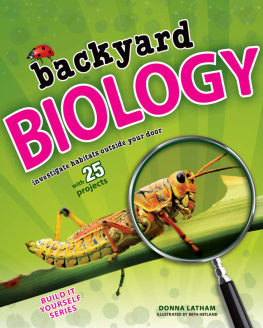
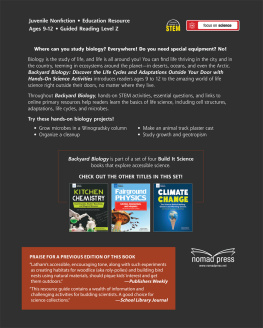
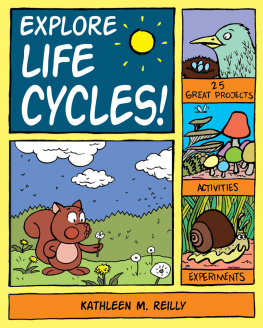
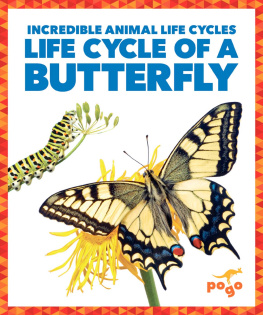

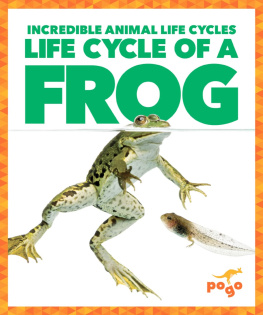
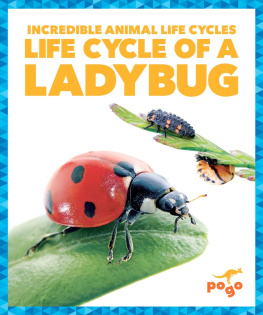
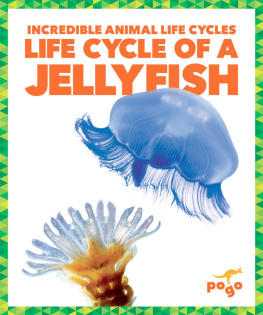


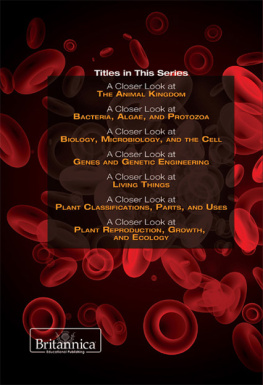
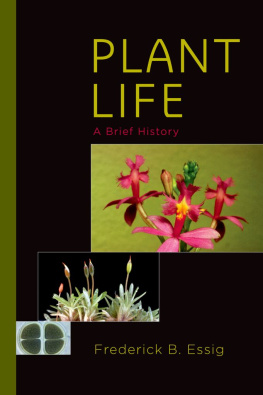


 Nomad Press is committed to preserving ancient forests and natural resources. We elected to print Backyard Biology: Investigate Habitats Outside Your Door on 4,007 lbs. of Williamsburg Recycled 30% offset.
Nomad Press is committed to preserving ancient forests and natural resources. We elected to print Backyard Biology: Investigate Habitats Outside Your Door on 4,007 lbs. of Williamsburg Recycled 30% offset.

